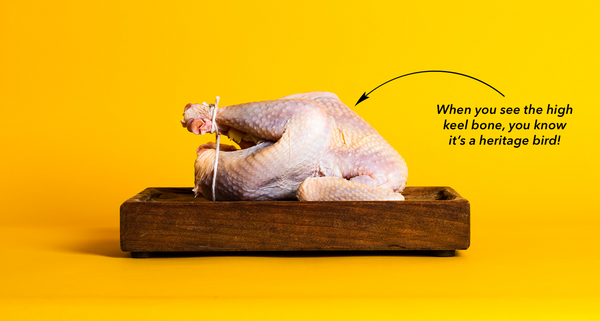
Heritage Chicken and the Keel Bone
Our Heritage breed chickens are unlike what you may very well be used to: they taste different from supermarket chickens, they look different, and even need to be cooked differently (low and slow) to bring out their wonderfully intense, natural chicken flavor. The keel bone stands out as an example of how a Heritage chicken stands apart from its supermarket counterparts. Prominently extending from the sternum, the keel bone offers a sturdy point for the wing muscles to attach to. But this bone is much more pronounced on Heritage birds
A corporate chicken, the kind favored by fast-food companies, is hardly a chicken at all. It is a hot genetic mess of an animal. When they came across one of nature’s mistakes — say, a chicken so top-heavy with breast meat that it could barely walk—they pulled it from the flock, not to kill it in an effort to protect the group from bad genes, but to ensure that its abnormal genetics became part of the next year’s harvest. Our livestock are so overbred for fast and unnatural growth that their bones are weak — a quarter of all chickens arrive at the slaughterhouse already injured and in pain. If you grew as fast as one of these birds, you would weigh 349 pounds at age two.
This genetic engineering fundamentally altered the skeleton of the chicken, made possible by breeding in the dwarf gene. Frank Reese explains, “This not only shortened the keel bone but also shortened the legs and wings. This is why the modern broiler waddles when it walks. Because of its short breast bone and short stubby legs it can no longer walk normally.”
Heritage chickens, however, are different. The pure, Standardbred genetics of Frank Reese’s flock result in a pronounced keel bone. It’s one of the easiest differences to spot in a Heritage bird. The prominence of this bone draws attention to the smaller breasts on these birds, but that’s a good thing! Selective breeding by massive poultry corporations has conditioned us into expecting and enjoying large chicken breasts, which is an utterly unnatural trait.
What the Heritage chicken loses in breast size it makes up for in flavor, juiciness, and texture. It is a truly different experience eating a Heritage chicken. Next time you roast one up, take a look at that keel bone.
